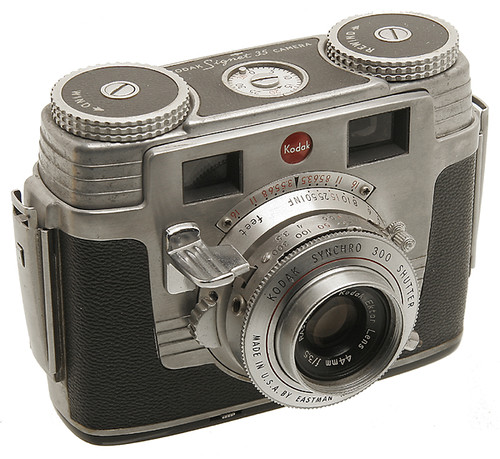Kodak Signet 35

|
| Kodak Signet 35 (1952) image by Rick Soloway (Image rights) |
The Kodak Signet 35 was Kodak's top American-made 35mm camera of the 1950's and the first of the Kodak Signet camera line. The Signet 35 has a coupled coincident image rangefinder, an excellent Ektar 44mm f3.5 lens with rear helicoid focus, automatic film stop counter with double exposure prevention, all built into a sturdy cast aluminum alloy body. The manually cocked Kodak Synchro 300, shutter works well, but compared with the shutters on equivalent German and Japanese cameras of the period, it has significantly fewer speeds (B, 1/25, 1/50, 1/100, and 1/300). However, time has proved the shutter to be very reliable, especially when compared to some of Kodak's leaf shutters of more impressive specifications.
The Signet 35 originally sold for $95 USD[1] (app. $810 USD in 2007). The design was by Arthur H Crapsey, and it was made between February 1951 - March 1958[2].
The Signet 35 is a very interesting camera as it shows some design details that make it special, however not comparable to German and Japanese counterparts of the time. The lens was the Tessar formula adapted to newer glass types and the focal distance (44mm) is the closest to the diagonal for 35mm film(43.3mm). Maximum aperture was that of the original Tessar design it is 3.5 closing up to 22. Lens performance is excellent even for today´s standards and is coated and colour corrected. It´s an extremely strong camera because the body itself is a thick cast machined aluminum single piece. Both advance and rewind functions are operated by big toothed wheels, able to be operated with gloves. The shutter release button is a big plate able to be operated, again, with gloves. The shutter itself is an extremely simple design having big levers to set both speed and aperture (also allowing to use gloves). Another unusual feature is the film pressure plate which, instead of being flat black, is made of a bright mirror finished chromed plate. The flash sync contact is the by then standard ASA type and Kodak sold an adaptor for PC units. Synch was only for bulbs (M type) No X synch unless the shutter is modified to this purpose. Another interesting feature is that the camera allows for multiple exposure by just moving a lever in the bottom plastic plate. The massive focusing assembly is made with ball bearings making it easy and smooth, the focusing lever, again is able to be used with gloves because of its size. Distance scale is only engraved in feet meaning it wasn´t intended to be sold overseas. Focusing can be done up to a mere two feet (610 mm) which is unusual for an RF without parallax correction not even with a projected field frame in the viewfinder. There are two other versions: one finished in black anodized aluminum made for the USAF, and another finished in olive green made for the Army. The camera itself is made of aluminum alloy (body), chromed brass and some stainless steel parts.
Considering the price of this camera when released (USD 95.00), much more expensive than other models of the same series (Signet 40 - USD 50.00), speculation exists that this camera was a civilized version of a camera originally designed for the military, and that would explain its design. What remains is that the designer made a simple and strong camera, able to survive exposition to a very harsh environment, easily serviced, while still being capable of extremely high quality results.
Another interesting as well as unusual feature is the sliding rule type exposure calculator (that´s in the removable backplate), which is set for the available (at the time) film. The calculator is built upon two small sliding rules that shows suggested exposure settings depending on lighting conditions, and is very accurate but relying on personal experience and intended for use with Kodak made film only, or at least with film of same ASA / ISO rating. This also avoids the need for an exposure meter if the operator was adequately trained in determining lighting conditions.
| Text in Spanish / Texto en Castellano | |
|
La Kodak Signet 35 era una cámara fotográfica de 35mm, americana de gama superior de Kodak de los años 50. Es telémetrica, con objetivo excelente Ektar de 44mm/f3.5, con el foco helicoide posterior, contador automático de película, con un sistema de doble prevencion de la exposición, construida todo en un cuerpo robusto de aleación de aluminio moldeado. Se tiene que cargar manualmente el obturador. El obturador funciona bastante bien, pero comparado con los obturadores en las cámaras fotográficas alemanas y japonesas equivalentes del período, es verdaderamente inferior. Diseñado por Arthur H Crapsey, y se realizó entre febrero de 1951 y marzo de 1958. | |

|
| Kodak Signet 35 (1952) image by jgs4309976 (Image rights) |

|
| Kodak Signet 35, USAF model image by David Sides (Image rights) |
Notes
Links
- PDF Manual on Mike Butkus's site
- Repair Notes at Daniel Mitchels Camera Collecting and Restoration
- Signet 35 at Sylvain Halgand's www.collection-appareils.fr (in French)
- History of Kodak Cameras (archived)